

A Step by Step Guide to
Exporting Forages to the United States

January 2001
Agriculture and Agri-Food Canada
Market and Industry Services Branch
402 -303 Main Street
Winnipeg, MB
R3C 3G7
Prepared in collaboration with
Brandy Laycock
Marketing and Trade Officer
For futher information contact:
Dan Wuerch (204) 984-4230
Hector Urbina (204) 983-3835
Table of Contents
1.1 Manitoba Grown
1.2 Manitoba Seed Varieties
1.3 The Benefits of Forages
1.4 The Role of the Hog Industry
2. CANADA'S INSPECTION, GRADING AND QUALITY CONTROL SYSTEM
2.1
Hay & Straw Certification Program - Manitoba Forage Council Inc.
2.2
Manitoba Green Gold Program - Manitoba Agriculture
2.3 The Canadian
Phytosanitary Certificate
2.4 Feed Testing
Laboratories - Feed Analysis
2.5 Relative Feed Value
2.6 Moisture Content
3.1
Product form of Pellets and Cubes
3.2 Product Form of Bales
3.3 Alfalfa Meal and Pellets
3.4 Alfalfa Cubes
3.5 Compressed
Bales of Alfalfa and Timothy Hay
5. UNITED STATES MARKET PROFILE
5.1 Total Cattle
Inventories
5.2 Dairy Production
5.3 Beef Production
5.4 Hay Production
5.5 Alfalfa Production
6.1 Alfalfa
6.2 Baled Hay Imports
6.3
Feed Composition of Dairy and Horse Farms and Substitute Products
8. PREPARING THE PRODUCT FOR EXPORT
8.1 Resource Planning
8.2 Financial Services
8.3 Methods of Financing
8.4 Choosing a Distribution
Channel
8.5 Transportation
8.6 Labelling,
Packaging, and Import Requirements
8.7 Tariffs in the United
States
8.8 Media and Advertising
The Manitoba Forage Industry
EXECUTIVE SUMMARY
Forage production and marketing lends itself well to Canadian agriculture where traditionally specialty cash crops have been limited by our growing season, moisture conditions, temperature and soil type. When the industry experiences depressed commodity prices, high quality forages sold in the export market have provided an alternative source of income. As demand for farm diversification increases, forages may provide an excellent source of growth opportunity in Manitoba.
Japan, the United States and South Korea are some of our largest buyers. Though Mexico's economic importance is less, they too play an essential role in our export market. As market access improves in Mexico, one can expect to see a large growth potential there.
Entering the global market place is not always easy to do but, through research and hard work, the results may be very rewarding. Before going global, there are several questions you should ask:
- What are the potential markets?
- What does the consumer demand?
- What are the costs of production and transportation?
- What restrictions exist?
- What about regulations and documentation?
This book will provide practical information to guide you on your export journey.
1 FORAGE INDUSTRY OVERVIEW
Across Canada, more than 26 million hectares annually are set aside for ruminant grazing and forage production. Of those acres, approximately 15 million hectares are native range, 4 million hectares are pasture and around 6 million hectares are cultivated forages for hay and pasture. With Canada's cool, moist climate lending itself well to quality hay and forage production, it is surprising that off-farm hay sales represent less than 15 per cent of total production.
Our reputation for quality forage products has allowed us to better position ourselves globally. With continued efforts, our export potential will grow. Nationwide, alfalfa meal and pellets have been to date one of our largest export commodities with $41 million in sales being shipped in 1999 alone. However, as we have seen the demand for meal and pellets drop off, the hay market has stepped up to become our largest export market with $49 million in sales in 1999.

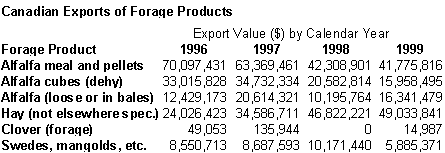
Manitoba's exports of alfalfa and hay have been typically the larger portion of our export market. From 1998 to 1999, alfalfa baled exports declined by 50%, while hay (not elsewhere specified) numbers rose from approximately 4,000 to 6,800 tonnes.
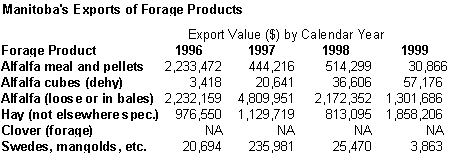

It should be noted that these numbers may be underestimated according to statistics reported by the importing countries. Alberta Agriculture's annual surveys also have shown larger quantities and export values. Part of this underestimation may be due to the fact that Canadian producers are not required to report exports of less than $2000.
1.1 Manitoba Grown
Manitoba's key forage producing regions exist in both North and Southwestern parts, as well as the Interlake, although production is scattered throughout the province. The excellent alfalfa and timothy produced, along with other forage crops, have been traditionally used for beef and dairy operations within the province. Of Canada's total tame hay production in 1998, Manitoba contributed 12.6 per cent, which was up substantially from 10.2 in 1997.
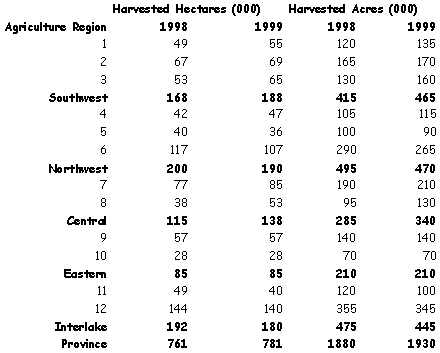
Source: Manitoba Agriculture Yearbook, 2000
1.2 Manitoba Seed Varieties
Numerous varieties can be grown in Manitoba. Alfalfa, alfalfa/bromegrass mix, and timothy are among some of the most common hay and forage crops produced. By consulting the "Seed Manitoba - Variety Recommendations and Growers Directory" published by the Manitoba Cooperator, the Manitoba Seed Growers Association and Manitoba Agriculture and Food, one can select the most appropriate variety for a given region.
1.3 The Benefits of Forages
Forage crops such as alfalfa can provide numerous agronomic and environmental benefits. Leguminous crops like alfalfa can provide substantial amounts of nitrogen that can be broken down gradually and released over time. Nitrogen benefits of alfalfa can also be seen through nitrogen extraction up to 260 cm deep. Because of nitrogen fixation and breakdown, 71 per cent of producers in Manitoba and Saskatchewan have indicated a yield increase in their traditional crops when forages are used in their crop rotation.
Studies have shown that after a two or three-year stand of a forage crop in rotation, weed stands can also be significantly reduced. With less weed pressure, fewer herbicides are required. Forages can use water from lower depths than most typical crops because of the extensive deep-rooted system.
For more information on the benefits of forages, check out this website:
http://www.umanitoba.ca/faculties/afs/plant_science/
EXTNBLTN/agrif95.html
1.4 The Role of the Hog Industry
With almost 5 million hogs in the province, manure handling and disposal has become an issue. Public concerns have focussed on the threat of E. coli and water contamination.
Forages can play a very important role when manure is applied in the appropriate manner; it can be an excellent source of fertilizer for crops. Different crops require distinctly different amounts of nitrogen. Forage crops like alfalfa can use substantially more nitrogen than most crops, especially cereals. Because they are deep rooted, they are capable of retrieving nutrients that would have otherwise been lost by leaching into groundwater.
As well, preliminary trials in Saskatchewan have shown that one application of hog manure may provide adequate soil nutrients for up to three years. The ammonium part of the manure, which is readily available to plants, is used immediately while the organic portion is broken down over the growing season and subsequent growing seasons. Generally, 30 to 50 per cent of the nitrogen will be mineralized during the first cropping season with the remainder mineralized during future years.
2. CANADA'S INSPECTION, GRADING AND QUALITY CONTROL SYSTEM
Canada has been traditionally known for its top quality hay. However, in the past, there have been few standards put in place to ensure consistent quality. Since the export market requires quality and consistency, a few programs have been implemented to help producers meet the needs of their customers.
2.1 Hay & Straw Certification Program - Manitoba Forage Council Inc.
The Hay Certification Program is voluntary. Through the program, a producer arranges to have their hay certified by a trained, unbiased inspector. The inspector randomly chooses bales and visually inspects them to determine the species and mixture as well as colour, odour, foreign materials, etc. A sample also is taken from each lot to determine the chemical analysis. A "lot" is defined as hay that is of the same species, from within the same field, at the same stage of maturity, cut within the same 48-hour period. Smaller lots from the same field may be required if rain damage has occurred, or there is variation in soil, weeds or hay species within the same field.
Once the hay is inspected, it will be described according to several components, such as:
- leaf attachment
- stem size and texture
- percentage of grass or legume
- percentage of moisture
- crude protein
- calcium
- phosphorous
- total digestible nutrients (TDN), acid detergent fibre (ADF), neutral detergent fibre (NDF) and relative feed value (RFV)
Through the Hay Certification Program, buyers will be able to determine exactly what they are getting without having to see the hay first. Prices will also be established more appropriately when the quality has been accurately recorded. Once the hay has been certified, it can be placed on the Manitoba Forage Council's Certified Haylisting accessible via the internet.
For more information on the Hay Certification Program, please contact:
Manitoba Forage Council Inc.
123 Dickens Drive
Winnipeg, Manitoba R3K 0M1
Tel: (204) 889-5699 Fax: (204) 897-4086
Email: mfc@escape.ca
2.2 Manitoba Green Gold Program - Manitoba Agriculture
This program helps producers determine the best harvest date needed to maintain high quality forages. Manitoba Agriculture and Food, local producers and sponsors have been jointly developing this program for several years. Alfalfa fields are sampled in each region of the province two times a week throughout June. These samples are analyzed at Norwest Labs and the results are faxed back to Manitoba Agriculture and Food as well as the producers within 24 hours.
Through this program, it has been determined that most alfalfa fields reach the optimum 150 relative feed value (RFV) at the early to mid-bud stage. It has also been seen that the RFV drops an average of five points per day. For every year this program has been implemented, optimal harvesting dates have been recorded in order to reach 150 RFV. This date will vary from region to region, so it is best to contact your regional forage specialist. In order to reach 150 RFV, producers must cut the crop at 165 RFV because one can expect to lose about 15 points during harvest due to leaf loss and continued respiration.
The RFV is determined by a lab analysis that compares the acid detergent fibre (ADF) that indicates the forage digestibility, and neutral detergent fibre (NDF) that provides an indication of potential daily forage dry matter intake. RFV has become an industry standard for measurement with 150 RFV being optimal.
For more information on Manitoba's Green Gold Program, visit the website at: http://www.gov.mb.ca/agriculture/news/greengold/gginto.html
| Northwest Region | Pam Iwanchysko | Ethelbert | (204) 742-3779 |
|---|---|---|---|
| Central Region | Vaughan Greenslade | Portage La Prairie | (204) 239-3366 |
| Southwest Region | Jane Thornton | Brandon | (204) 726-6409 |
| Eastern Region | Fraser Stewart | Beausejour | (204) 268-6014 |
| Interlake Region | Kevin Yaworski | Ashern | (204) 768-2781 |
2.3 The Canadian
Phytosanitary Certificate
A phytosanitary certificate is an official document issued by the plant protection organization of the exporting country to the plant protection organization of the importing country. It certifies that the specific shipment of the plants and plant products covered by the certificate are free from quarantine pests, practically free from other injurious pests and meets the importing country's requirements. With the completion of the document, including an authorizing stamp and signature, the responsibility rests with Agriculture and Agri-Food Canada and in particular the inspector.
For each importing country, the phytosanitary document may be different. Check with the Canadian Food Inspection Agency for specific information at:
59 Camelot Dr.
Nepean, Ontario K1A 0Y9
Tel: (613) 225-2342
Fax: (613) 228-6621
or contact
Taras Happychuk, Mid-West Region:
613-269 Main Street
Winnipeg, Manitoba R3C 1B2
Tel: (204) 983-2200
In order to apply for the phytosanitary certification process, a copy of the relevant hay inspection report must accompany each application form (Application for Export Inspection and Phytosanitary Certification).
2.4 Feed Testing Laboratories - Feed Analysis
By providing a feed test and analysis of your forage or hay product, purchasers are able to more clearly determine the kind and content of the forage. A feed analysis will determine the moisture content, relative feed value (RFV), crude protein, phosphorous, total digestible nutrients, and others. Hay and Forage Grower, a publication made available to Manitoba Forage Council members, also provides a list of accredited labs in Canada and the U.S.
For U.S. labs, you can visit a website called A2LA at www.a2la.org/ . This website is the American Association of Lab Accreditation in the United States. They can also be contacted at Tel: 1-301-670-1377 or Fax at: 1-301-869-1495.
For a complete Canadian list, contact the Canadian Food Inspection Agency at: www.cfia-acia.agr.ca or call: (613) 225-2342 or Fax: (613) 228-6621.
Locally there are a few Canadian Food Inspection Agency approved labs:
Norwest Labs
Agricultural Services Complex
203-545 University Crescent
Winnipeg, MB R3T 5S6
Enviro-Test Laboratories
(Saskatchewan Soil Testing Lab)
University of Saskatchewan
General Purpose Building
Saskatoon, SK S7N 0W0
Central Testing Laboratory Ltd. (not SCC approved)
101-193 Dumoulin Street
Winnipeg, MB R2H 0E4
There are several components that are used to measure quality in hay. Quality is very important in the export market. Without consistently high quality product, our exporters may lose interest.
2.5 Relative Feed Value
Optimal relative feed values (RFV) can differ depending on your end market. For example, in the dairy industry an RFV of 150 is optimal. However, beef cow/calves or heifers may only require an RFV of 120. Knowing your market can be very important. Potential exporters also should be aware that timothy hay, unlike alfalfa is often valued more for its appearance.
There are several guides that can help you determine the optimal RFV, like the Manitoba Green Gold Program and Manitoba Agriculture and Food. See also a brochure called Marketing Your Cash Hay, a publication funded by the Manitoba Farm Business Management Council, and distributed by the Manitoba Forage Council (MFC) and Manitoba Agriculture and Food. PEAQ sticks, available through Manitoba Agriculture and the MFC are also useful in determining your RFV.
2.6 Moisture Content
Moisture content is an important consideration for hay quality. Most foreign markets want a moisture content of 12 per cent or less, while domestic markets will allow for between 14 and 18 percent depending on the bale size and density. Most processors require 12 per cent, however dryers have eliminated this problem for many. When marketing hay, moisture testing using a Koster or microwave tester is very important. Probes are useful, but not always accurate.
Manitoba Agriculture and Food suggests the following process be used to measure forage dry matter:
- Weigh an empty paper plate.
- Put about 200 grams of hay on the plate and weigh it. Write down total weight.
- Put the plate and sample in a microwave oven with a cup of water. (It is important to have the cup of water.)
- Microwave on high for three minutes.
- Remove the plate and sample and weight them. Write down the weight.
- Put the plate and sample back into the oven and microwave on high for one more minute.
- Continue heating the sample at one minute intervals and weighing in between until the sample stops losing weight. Record the final weight.
- Now plug the numbers into the following formula:
- % of forage dry matter = Final weight of sample and plate minus weight of plate X 100%
- Original weight of sample and plate minus weight of plate
In the field for a general idea, you can also use this method:
- 30-40% Leaves begin to rustle and do not give up moisture unless rubbed hard. Juice can be squeezed easily from stems using thumbnail or knife or with difficulty by twisting hands.
- 25-30% Hay rustles. A bundle twisted in the hands will snap with difficulty, but should show no surface moisture. You can squeeze moisture from thick stems if you scrape them with your thumbnail.
- 20-25% Hay rustles readily. A bundle will snap easily if twisted. Leaves may shatter. A few juicy stems may remain.
- 15-20% Swathed hay breaks easily. A bundle will snap easily when twisted. Juice is difficult to squeeze out. Hay is close to being ready to bale.
(Chart published in Hoard's Dairyman, 1987.)
3. VALUE ADDED PROCESSING
Hay can be processed into a variety of forms, some of these include dehydrated alfalfa pellets, sun-cured alfalfa pellets, alfalfa cubes, and compacted bales. The specifications commonly used in Canada are as follows:
3.1 Product form of Pellets and Cubes
Typical nutrient specifications for the major alfalfa products are as follows:
| Specifications | Dehy Alfalfa | Suncured Alfalfa | Alfalfa Cubes |
|---|---|---|---|
| Crude Protein, % |
18.9 | 17.0 | 17.0 |
| TDN, % | 66.6 | 61.5 | 61.0 |
| Crude Fiber, % | 25.0 | 28.0 | 28.0 |
| ADF, % | 34.0 | 35.0 | 35.0 |
| Calcium, % | 1.50 | 1.50 | 1.50 |
| Phosphorous, % | 0.22 | 0.21 | .021 |
| Potassium, % | 2.39 | 2.35 | 2.35 |
| Copper, mg/kg | 11.0 | 11.0 | 11.0 |
| Manganese, mg/kg | 34.0 | 34.0 | 34.0 |
| Zinc, mg/kg | 21.0 | 21.0 | 21.0 |
| Magnesium, % | 0.32 | 0.32 | 0.32 |
| Selenium, mg/kg | 0.37 | 0.35 | 0.35 |
| Moisture, % | 10 | 10 | 12 |
| Sizes, mm | 6-9 | 6-9 | 20-40 |
These are typical specifications for Canadian Alfalfa Products (100% Dry Matter Basis).
3.2 Product Form of Bales
Hay is typically compressed into a 14" x 18" X 18" bale, weighing approximately 80 lbs, and banded with three to four poly straps. The densified bales are then loaded into 40 foot containers and shipped to an inland container yard, and moved to port by rail. Each individual processor may work with different sized bales, so it is best to determine the local requirements. Small square bales are most commonly used, however large round or square bales can also be rebaled.
3.3 Alfalfa Meal and Pellets
In 1996, alfalfa meal and pellets comprised one of the largest export markets for Manitoba. More recently, the market has dropped off and baled alfalfa and hay have stepped up to take the lead. In 1999 in Manitoba, approximately $31,000 of meal and pellets were exported, while Canada as a whole exported closer to $42,000,000 worth. Sun-cured pellet production has dropped the most substantially. Dehy pellets have dropped only slightly and are expected to rebound. In Canada, 32,400 tonnes of sun-cured alfalfa and 315,000 tonnes of dehy pellets were exported in 1998-99.
Dehydrated and sun-cured alfalfa pellets are the most common. These pellets are finely chopped and dried and processed into small pellets. Because of the processing, dehydrated alfalfa has a higher crude protein level and lower crude fiber than sun-cured alfalfa. The main processing difference is that sun-cured alfalfa is wilted before processing, while dehydrated alfalfa is dried fresh from the swath. Pellets must by dried to 8 per cent moisture for optimal storage and shipping.


Japan has been by far the largest importer of Canadian alfalfa meal and pellets. In fact, we are the main supplier to Japan's pellet industry. The numbers have been gradually declining however. In 1994, 275,246 tonnes were exported, then in 1998 only 133,737 tonnes were exported. United States, South Korea and Taiwan are our next major importers. However, their imports from Canada have almost been cut in half over the same time period.
3.4 Alfalfa Cubes
Alfalfa cubes are coarsely shredded, field dried or high temperature dried alfalfa. The two most common sizes are 7/8" and 1". Canada supplies approximately one quarter of the Japanese import market, while the United States supplies around three quarters. Manitoba's exports, though minimal, have been growing over the past five years. Japan is consistently the largest importer of Canadian alfalfa cubes.
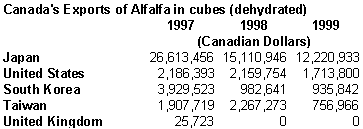
Manitoba's two alfalfa processors are:
- Alfalfa Products Ltd., located near Fort Whyte, is one Manitoba company that exports dehydrated alfalfa pellets to regions such as Hong Kong, South Korea, the United States, Japan and Taiwan.
P.O. Box 90, Fort Whyte
Winnipeg, MB R3Y 1G5
Tel: (204) 488-5059 Fax: (204) 489-2257
Contact: George Stilwell, Manager
- Coldstream Alfalfa Processing, located out of Dauphin, Manitoba, has also been an active exporter of dehydrated alfalfa pellets to the United States primarily. This company also produces a variety of other forage and hay products for export.
P.O. Box 337, Keays Industrial Road
Dauphin, MB R7N 2V2
Tel: (204) 638-3812 Fax: (204) 638-3963
Contact: Chris & Kathy Skuter
3.5 Compressed Bales of Alfalfa and Timothy Hay
Compressed hay has a bulk density of approximately 20 pounds per cubic foot or more, and is manufactured by mechanical or hydraulic compression from low density field baled forage in chopped, round or square bales. There has been a steady increase in exports of timothy hay to Japan from Canada. The United States is the second most important market for hay, followed by South Korea. The alfalfa hay industry has been maintaining production levels while timothy exports have risen significantly.
Manitoba's hay processors are:
Sunridge Forage Ltd.
Box 250
Russell, MB. R0J 1W0
Tel: (204) 773-2013 Fax: (204) 773-3137
Contact: Gary Halwas
Canadian Greenfield Forages Inc.
Box 155
Teulon, MB. R0C 3B0
Tel: (204) 886-2676 Fax: (204) 886-3722
Contact: Irvin Helwar
Lake Winnipeg Hay Company
Box 310
Fisher Branch, MB. R0C 0Z0
Tel: (204) 372-8600 Fax: (204) 372-6798
Chapman Bros. Farms Ltd.
Box 490
Virden, MB R0M 2C0
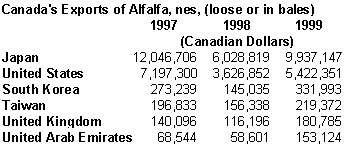
For more information on the Canadian processed forage industry, contact the Alberta Agriculture, Food and Rural Development, Markets and Economics, Market Analysis Unit at www.agric.gov.ab.ca and request a copy of The Canadian Processed Forage Industry Report.
4. FORAGE PRODUCTION
Forage production for the export market is extremely different than typical forage acres. Foreign markets are looking for high quality product. "High quality" can be defined differently depending on the end market. It is particularly useful to select for your end market and understand their needs before you begin production. Several manuals have been published to walk you through from variety selection to weed control to harvest.
Manitoba Agriculture and Food have numerous fact sheets and books. You can access these directly by contacting your local agriculture office, or by visiting: http://www.gov.mb.ca/agriculture/crops/forages/index.html
Industry News is available by visiting:
http://www.gov.mb.ca/agriculture/news/agmarks/agmarks.html
http://www.agric.gov.ab.ca
http://www.agr.gov.sk.ca
Other publications include:
- Seed Manitoba - Variety Recommendations and Growers Directory, Manitoba Cooperator, Manitoba Seed Growers Association, and Manitoba Agriculture and Food
- Forage Seed Production Manual, Manitoba Forage Seed Association
- Timothy Production Manual, Canadian Hay Association
- 2000 Forage Crop Production Guide, Saskatchewan Agriculture
- Alberta Forage Manual, Alberta Agriculture, Food and Rural Development
5. UNITED STATES MARKET PROFILE
5.1 Total Cattle Inventories
Canada is the largest supplier of hay products to the United States. Exporting to the United States can be very dependent upon weather conditions. Although exports to the United States occur annually, during periods of drought the volumes shipped may be substantial.
The cattle and calf (dairy and beef) inventory provides an indication of those states using hay products. The highest concentration is in the mid-United States. This region stretches from Minnesota straight down to the biggest cow state of all, Texas. Texas has a whopping 13.9 million head of cattle, accounting for 14% of all cattle production in the U.S.. This mid-region includes primarily Nebraska (6.7 million head), Kansas (6.6 million head), and Oklahoma (5.2 million head), but also includes South Dakota, Iowa, Montana, Wisconsin, Minnesota, and Colorado. Outside this region, California has a substantial inventory of 5.1 million head or 5% of the total.

5.2 Dairy Production
California is the number one producing dairy state with 1.5 million head or 16% of total dairy herd. Other regions in the United States include parts of the mid-west (Minnesota, Wisconsin, Michigan, Ohio) as well as Pennsylvania and New York. These five states account for 3.8 million head or 41% of the total herd. Towards the western sea board, Washington and Idaho account for 246 thousand and 332 thousand head respectively. While New Mexico and Texas contribute 236 thousand and 350 thousand head respectively.
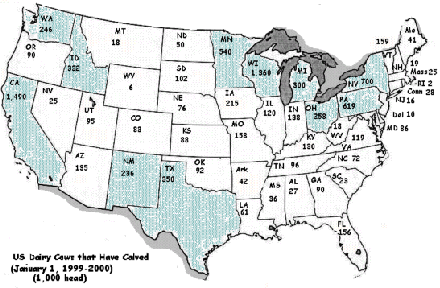
5.3 Beef Production
The beef inventory situation is similar to the total cattle scenario. The mid-continental region is the main beef rearing area. Texas has the largest herd with 5.4 million head or 16% of the total. Outside this mid-continental region, two key players are Florida (944,000 head) and California (780,000 head).
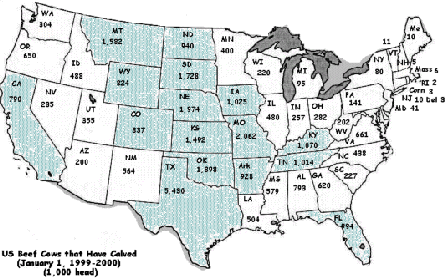
5.4 Hay Production
The major hay growing regions align closely with the beef producing areas. Total hay production in the U.S. amounted to 159 million tons. Hay production is predominant in the central U.S. extending from Montana and Minnesota to Texas. Texas is the largest producing state at 13 million tons or 8% of the total. This year, however, Texas has experienced an enormous drought and hay production is expected to be significantly lower. California also grows substantive amounts (8.5 million tons).
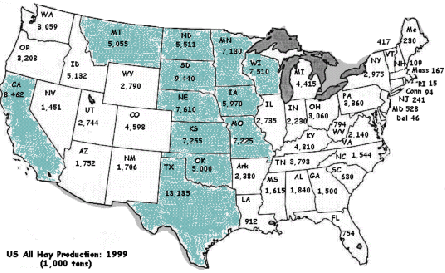
5.5 Alfalfa Production
Production of alfalfa and alfalfa mixtures do not often extend as far south. This region typically goes from Montana across to Wisconsin, and down to Colorado and Kansas. Within this region, the largest producing state is Wisconsin (6.5 million tons in 1999). Beyond this region, California, the largest producing state, grew 7 million tons in 1999.
Based on October 2000 USDA estimates, yields for 2000 suggest record levels in eleven Midwest and Eastern States. However, serious drought conditions exist in the west and Southern Plains with Kansas, Texas, Oklahoma, Missouri, Montana and Oregon all having reduced yields.
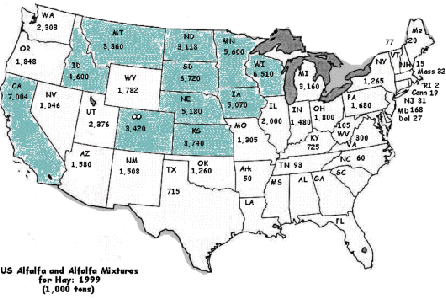
6. MARKET FOR PRODUCTS
6.1 Alfalfa
The United States is Manitoba's number one customer for alfalfa meal and pellets. Typically our customers have been North and South Dakota, Minnesota, and Montana. However, as more innovative transportation methods are developed, and as demand expands further south, our export area continues to grow. Compacted bales can be moved longer distances as they are more economical to ship than standard bales. The southeast market tends to require top quality hay for the race horse market and is willing to pay premiums for quality product. This market is difficult to break into, and often just as difficult to persuade a broker or dealer of a race track to represent your product. The race horse industry typically looks for a product based on such factors as colour and softness rather than analysis focusing on laboratory. The horse industry prefers regrowth grass such as Orchard grass or Timothy grass, but it is starting to use more alfalfa, with mixes anywhere from zero to fifty percent.
According to Statistics Canada, the United States is the third largest market for Canadian alfalfa pellets and baled hay. Many Canadian producers ship alfalfa and alfalfa-mix bales to both the dairy and horse race markets. Several factors have contributed to the increasing U.S. demand for Canadian hay including increased urban sprawl, reduced irrigation capabilities and increased water monitoring. The water shortages are especially evident in California.
The New England market, often supplied by Ontario and Quebec, has seen increased imports from Manitoba in recent years. The New England region has recorded a sharp decline in production since the mid 1920's from 13 million acres to five million acres. Poor moisture conditions in 2000 will aggravate this situation. With large dairy producing regions, the demand for alfalfa will be strong.
6.2 Baled Hay Imports
The horse sector in the United States located in the mid west and southeast, has been requiring an increasing supply of regrowth grass and crops like Orchard grass and Timothy. States such as California and Florida have the largest concentration of race tracks and race horses.
6.3 Feed Composition of Dairy and Horse Farms and Substitute Products
Alfalfa and alfalfa mixture production in 2000 is forecast to be down 5% from 1999 to 80 million tons. It is estimated that 23.3 million acres were harvested. The alfalfa market continues to dominate the hay and forage industry. California remains the leader in alfalfa hay production, followed by South Dakota and Wisconsin.
The mid west and eastern states experienced record yields in 2000, while the west underwent drought conditions. The southern plains, especially Kansas, experienced severe drought. Texas, Oklahoma, Missouri, Montana and Oregon all recorded lower yields.
Other hay types grown include Timothy hay, prairie hay, precut rye, straw, dehy and suncured alfalfa pellets, and alfalfa cubes. Of these other hay types, production is forecast to be 3% below last year's level for a total yield of 72.7 million tons. This is the second highest since 1962 according to Thomas Morgan. The east has mostly experience record yields, while the west remains spotty.
7. TRADE FAIRS
World Dairy Expo - Madison, Wisconsin
2820 Walton Commons West, Ste. 101
Madison, Wisconsin USA 53718-6797
Tel: 608-224-6455 Fax: 608-224-0300
e-mail: wde@wdexpo.com
- Showcases the world's best dairy cattle and dairy technology. More than 70,000 dairy producers and agribusiness representatives attend annually. Share ideas with approximately 3,300 international buyers from 87 different countries.
- Often several members of the Manitoba Forage Council attend. Upon return, a complete list of contacts is made available for attendees.
North American International Livestock Expo - Louisville, Kentucky
- Known as the best mid-eastern fall national show around
Equitana USA - Louisville, Kentucky
- One of the world's largest international trade shows and equestrian gatherings in America. Equitana shows are held worldwide, including North America, Europe and the Pacific Rim.
Southern National Expo - Perry, Georgia
14625 Baltimore Avenue, Suite 164
Laurel, MD 20707-4902
Tel: (410) 451-9674 Fax: (253) 390-0522
- Includes clinics, competitions, entertainment, exhibitions, a livestock auction and a whole lot more.
Associations:
Local associations may be able to provide additional information or assistance. These associations include:
National
Canadian Alfalfa Seed Council
Canadian Forage Council
Manitoba
Manitoba Forage Council
Manitoba Forage Seed Association
Saskatchewan
Saskatchewan Forage Council
Saskatchewan Dehy Association
Saskatchewan Alfalfa Seed Producers Association
Saskatchewan Advisory Council on Forage Crops
Alberta
Alberta Forage Associations
- Battle River Research Group
- Chinook Applied Research Association
- East Central Alberta Forage Association
- Lakeland Agricultural Research Association
- Peace River Forage Association Alberta Forage Council Peace Region Forage
Seed Association Alberta Alfalfa Seed Producers Association
American
National Hay Association
http://www.haynha.org/
AgSource Soil and Forage
American Alfalfa Processors Association
http://www.aapausa.org/
American Forage and Grasslands Council
http://www.afgc.org/
InterMountain Hay Growers Association-California
http://forages.orst.edu/organizations/
IHGA/index.html
Colorado Hay and Forage Association
Idaho Hay Association
Indiana Forage Council
http://www.forages.css.orst.edu/
Organizations/Forage/IFC/
index.html
Nebraska Alfalfa Marketing Organization
Nebraska Wheat Growers Association
Oklahoma Alfalfa, Hay & Seed Assn
http://clay.agr.okstate.edu/alf-asso/
index-98.htm
Agriculture Fiber Association - Oregon
Central Oregon Hay Growers Association
http://www.forages.css.orst.edu/
Organizations/Forage/COHGA/index.html
Klamath Basin Hay Growers Association
Oregon Wheat Growers League
Pacific Northwest Forage Workers - Oregon
http://www.forages.css.orst.edu/
Organizations/Forage/PNWFW/ Frames/index.html
Washington State Hay Growers Association
http://www.forages.css.orst.edu/
Organizations/Forage/WSHGA.html
8. PREPARING THE PRODUCT FOR EXPORT
The U.S. market can be subdivided into three markets - the horse market, the dairy market and the beef market. The following summarizes the major product qualities looked for in each of these distinct markets.
Horse Market
- regrowth grass / alfalfa / mix
- often use more visual assessment than a feed analysis
- good colour and softness (i.e.. see Timothy requirements for Japan)
- packaging, palatability and price are important factors
- like "flaked" hay
- often small square bales (75-80 lbs.) - standard binding
- cubes often used
- moving towards medium bales with higher density (approximately 25 lbs/cu.ft. compacted)
- Caution: know your market first
- know your markets mechanized capabilities (do they want pallets, etc.?)
- straw market is used for bedding
Dairy Market
- based a lot on Total Mixed Ration (TMR) System
- high quality forage (feed analysis very important)
- want 150 Relative Feed Value (RFV) or higher
- often put into mixers or shredders after delivery
- square bales are typical because of reduced labour and the importer's mechanical capabilities
- some producers have been selling round bales, but usually with shorter hauls due to overwidth trucking restrictions in some states (check state requirements).
- high quality pure alfalfa is preferred
- opportunities exist for processed products (compact bales, pellets, cubes)
- protein and palatability important
- stage of maturity and colour important
- bales should be firm, uniform, good weight and stored on edge in dry, dark, well ventilated storage
- crop residues is used for bedding.
Beef Market
- buyers are interested in protein and palatability with price a consideration
- grass/legume mixtures
- large round bales are often preferred
- colour, leafiness and leaf-attachment are important
- crop residue is used for bedding
Alfalfa Hay
1. Freedom from Hessian Fly hosts
- cereals: wheat, barley, rye
- grasses: all Agropyron spp.; including quackgrass, crested wheatgrass, intermediate wheatgrass, etc., Hordeum spp.; wild barley (foxtail barley). The presence of other insects or disease also could result in the rejection of hay for export.
2. Colour
- leafy, good green preferred
- light green (celery colour) is acceptable
- sun-bleached acceptable but not desirable
- brown or weathered not acceptable
3. Moisture content
- 12 per cent maximum
- uniformly dryness
4. Crude Protein
- no standard (suppliers try to keep it in the 15 to 18 per cent range)
- lower levels may be acceptable on a special lot basis if it has good colour
5. Fibre
- no standard range of Acid Detergent Fibre (ADF)
- fibre is considered acceptable if crude protein is in the 15 to18 per cent range for alfalfa
- high fibre is required along with reasonable levels of other nutrients to maintain high milk fat and milk solids
6. Spoilage
- spoiled, weathered or dusty hay is not acceptable
- product should be free of moulds, weeds and soil
- Note: Guidelines are available for optimal alfalfa production for export.
Timothy Hay
1. Freedom from Hessian fly hosts
- same information as for alfalfa hay
2. Colour
- light green colour preferred
3. Moisture content
- 12 per cent maximum
4. Crude protein
- no standard
- long coarse stems with long plump heads
- preference for hay to be 15 cm in length, though no standards exist
- many large leaves
5. Fibre
- no standard
- main purpose for timothy
- used for race horses and dairy
Some compromises in quality may be made if appearance is good.
8.1 Resource Planning
Depending on the level at which you want to export, your resource requirements may differ. You will specifically need to identify your production capacity (as an individual or a processor), the necessary equipment, materials or ingredients, labour, administration, marketing, translation services, storage, local representation in the foreign market, financial services, packaging and shipping capacity, and the time/cost requirements.
8.2 Financial Services
This is one of the most import aspects of your export project. It is a good idea to explore several resources and options before you begin. There are government financing experts, as well as banking institutions. Several questions you should ask are: who will finance me, are they credible, for what period of time will I need to be financed, how much will I need and when, what insurance options are available, what institutions are represented well in the importing country, who will my importer deal with?
For export credit insurance, which protects the exporter in the case of insolvency or non-payment by the foreign buyer, it is a good idea to talk to:
The Export Development Corporation
http://www.edc-see.ca/index_e.htm
Or call them at 1-800-850-9626
2075-360 Main Street
Winnipeg, MB R3C 3Z3
Tel: (204) 983-5114
Toll free 1-888-332-3320
Other sources of finance expertise include:
Business Development Bank of Canada
www.bdc.ca
Winnipeg Office
1100-155 Carlton
Winnipeg, MB
R3C 3H8
Tel: (204) 983-7900
Brandon Office
940 Princess Avenue
Brandon, MB
R7A 0P6
Tel: (204) 726-7555
Local banks with branches/offices or affiliations with other financial institutions in the United States are also a potential source of financing options
When selecting a bank, make sure you know their credibility. Banks may also be able to offer credit details on foreign buyers, foreign currency services, information on loans and lines of credit, among others.
8.3 Methods of Financing
There are a number of methods that can be used to settle payment, including cash in advance, letters of credit used in conjunction with a documentary draft, promissory note, documentary collection or draft, open account, or consignment sales.
Letters of credit offer the most security for both the exporter and the importer. This method of payment is the easiest in a new market situation. Letters of credit (L/Cs) or documentary credits can be initialized through the importer and their issuing bank. Once the bank accepts the application, a letter of credit is drawn up and forwarded to the corresponding bank in the exporter's country (i.e. Canada). Once the exporter has shipped the goods and met all necessary requirements stated in the letter of credit, the exporter presents the necessary documents as proof of completion to their bank and is able to collect payment. These documents are then sent to the issuing bank, which provides them to the importer. The importer will need these documents in order to claim the goods. Through letters of credit, the importer does not have to make payment until the goods are received, and the exporter does not lose possession of the goods until payment has been delivered. There are different kinds of letters of credit, though the best form is the secured, irrevocable letter of credit because it guarantees that the issuing bank will cover the costs regardless of whether or not the importer does and it also insures that the agreement cannot be revoked once it has been finalized. To learn more about letters of credit, contact your nearest bank
There are several other professional services that can help you as well, including hay brokers, trading houses, and freight forwarders. Each has a special role to play. It is up to you to determine what services you as an individual can provide, and what resources you will require externally.
8.4 Choosing a Distribution Channel
1. Feed Ingredient Merchandisers/Brokers
There are several feed ingredient merchandisers and brokers in the United States. You can also choose brokers located in Canada.
Alfalfa Pellets
American Agco
American Brokerage Co.
Andy Lorence Co,
Animal Health Sales Inc.
C. B. Constantini Ltd.
Central States Enterprises Inc.
Cereal ByProducts Co.
Colorado Feeds
Eagle Milling Co. Inc.
Farmland Industries Inc.
Feed Services Inc.
Greenleaf Agri Products Inc.
Growmark Inc.
Gumbert Exchange
International Commodities Export Corp.
International Proteins Corp.
Interstate Commodities Inc.
Jones and Coontz Co.
LaBudde Group
LaCour-Dalton Co. Inc.
McGeary Grain Inc.
Messenger, J. F. Inc.
Mid-Central Products
North Central Companies
Ohio Alfalfa Blenders Inc.
Perdu-Shafer Inc.
Pestell Minerals & Ingredients
Pyramid Agric-Products Int'l.
(PAPI)
Scattergood, S.F. & Co.
Segal, Nathan, & Co.
Shippee, Charlie, Co. Inc.
Shull Alfalfa Products Inc.
Strate Grain Co.
W-P Milling Co. Inc.
Warren Feed & Grain Co.
Wilbur-Ellis Co.
Livestock Feed
Acadian Seaplants Ltd.
American Brokerage Co.
Consolidated Nutrition L.C.
Schuyler Laboratories Inc.
Ultimate Nutrients
Alfalfa, Dehydrated
Akey Inc.
American Brokerage Co.
C.B. Constantini Ltd.
Central States Enterprises Inc.
Farmland Industries Inc.
Growmark Inc.
Gumbert Exchange
Jones and Coontz Co.
LaBudde Group
LaCour-Dalton Co. Inc.
McGeary Grain Inc.
Messenger, J.F. Inc.
Mid-Central Products
North Central Companies
Ohio Alfalfa Blenders Inc.
Perdue-Shafer Inc.
Pyramid Agric-Products Int'l
(PAPI)
Segal, Nathan & Co.
Shull Alfalfa Products Inc.
Strate Grain Co.
Sunshine Feed & Grain Co.
Inc.
Thomas Laboratories
W-P Milling Co. Inc.
Warren Feed & Grain Co.
WMB Corp.
Alfalfa, Sun-cured
American Agco
American Brokerage Co.
Barker Trading Co.
C. B. Constantini Ltd.
Cereal Byproducts Co.
Colorado Feeds
Farmland Industries Inc.
Feed Services Ltd.
Growmark Inc.
Gumbert Exchange
International Proteins Corp.
LaBudde Group
LaCour-Dalton Co. Inc.
McGeary Grain Inc.
Messenger, J.F. Inc.
Miracle Feeds Inc.
MoorMan's
North Central Companies
Perdue-Shafer Inc.
Pestell Minerals &
Ingredients
Pyramid Agric-Products Int'l
(PAPI)
Segal, Nathan, & Co.
Warren Feed & Grain Co.
Wilbur-Ellis co.
Pricing
There are numerous ways of sourcing prices in the United States. Several internet locators and prices are available. Here are just a few:
- www.hayexchange.com
- http://www.escape.ca/~mfc/haylist.txt
- http://phoenix.acn.ces.purdue.edu/lcgi-bin/hay/welcome (more links!)
- www.forage.com (Morgan Forage Site)
- www.farmworld.com
- http://www.agr.state.tx.us/producer_info/hayhotline.htm (exchange and motor carriers for hire)
- http://www.wa-hay.org/ (Washington)
- http://www.stockmansdirectory.com/
- There are numerous websites, just do a "hay exchange" search
- Check newspapers
- Contact various hay associations like at this website:
http://www.forages.css.orst.edu/Organizations/Forage/
National.html#US
-this site lists national, regional, state, provincial forage organizations
PRICE - JUNE 2000

8.5 Transportation
Trucking Forages Into the United States (with farm trucks)
The following requirements must be met to use a farm truck to transport forages into the U.S.:
- Valid Driver's Licence
- U.S. Medical Certificate - Certificate forms available from:
Manitoba Trucking Association
25 Bunting St., Winnipeg, Manitoba R2X 2P5
Tel: (204) 632-6600 - Medical Insurance - obtainable from any general insurance agent.
- Log Books:
-log books are required in the U.S. for both mileage and fuel,
-quarterly reports must be filed,
-maximum driving time is 10 hours per day - Vehicle Registration - vehicles must be safetied in Manitoba, contact your nearest MPIC agent for further information.
- DOT Number - Required by each state's Department of Transportation to ensure safety regulations are met. They must be displayed on vehicle. There is no fee for farm-plated vehicles. Minnesota: (651) 296-3000 or North Dakota: (701) 250-4346.
- IFTA Registration:
-the International Fuel Trade Agreement requires registration,
-only amber fuel is allowed,
-decals must be displayed on cab,
-registration must be carried in cab,
-subject to an annual fee of $65 or $.06 per kilometer (maximum $18 per trip),
-Tel: (204) 945-3194 (Wpg.) Or 1-800-782-0318)
OR Temporary Fuel Permit - valid for 3 days within the state and expires upon exit. The cost is $30.00
- Liability Insurance - In Manitoba, the minimum is $1 million on tractor trailer units carrying non-dangerous goods. Some states require additional coverage. Contact the nearest MPIC agent for further information.
- NAFTA Certificate - This certificate costs $25 per year. Contact a customs broker in the yellow pages to obtain one.
- Hay Permits - Certain states require specific hay permits. See contacts in Table 1.
Other Requirements
- Flagging - for over-dimension loads. Red, orange, or yellow flags with a minimum 18 inch square must be visible on the front and the rear of the load.
- Night hauling - round bales or overwidth loads may NOT be transported at night.
- Mirrors - must extend past load widths.
- Strapping - each row must be side strapped and from front to back.
- Weight - maximum gross vehicle weight on U.S. highways is 80,000 lbs. except during winter months (December to March 7).
- U.S. customs - there is no duty on hay entering the U.S.
- U.S. brokers - one must pay commission to the broker (flat fee per load). Will need to know the load's destination, name of receiver and tax I.D. number if it is a commercial operation. Contact: J.L.Wood (701) 825-6241.
- Several states have plant or insect restrictions. Contact the local state agriculture office for specific state requirements.
| State | Permit Agency | Enforcement Agency |
|---|---|---|
| Montana | MT Motor Carrier Svcs. Division Box 4639 Helena, MT 59604-4639 Tel: (406) 444-6130 |
Montana Highway Patrol Motor Carrier Services Div. 2550 Prospect Ave. P.O. Box 201419 Helena, MT 59620-1419 Tel:: (406) 444-7638 |
| North Dakota | Vehicle Size & Weight Permit Tel: (701) 328-2621 |
Highway Patrol Headquarters Tel: (701) 328-2455 |
| South Dakota | SD Dept. of Commerce & Reg. Weights and Measures Pgm. 118 West Capitol Pierre, SD 57501 Tel: (605) 773-3697 Fax (605) 773-6631 |
SD Highway Patrol Motor Carrier Division 500 East Capitol Pierre, SD 57501 Tel: (605) 773-4578 Fax (605) 6046 |
| Nebraska | Dept. of Roads Permit Office Room 123A Box 94759 1400 Hwy 2 Lincoln, NE 68509-4759 Tel: (402) 471-0034 |
Carrier Enforcement 3920 W. Kearney St. Lincoln, NE 68524 Tel: (402) 471-0105 |
| Kansas | Kansas DOT Special Permits Section Tel: (785) 296-7400 |
Kansas Highway Patrol General Headquarters 122 SW 7th Street Topeka, KS 66603-3847 Tel:(785) 296-6800 Fax (785) 296-3049 |
| Oklahoma | Oklah. Dept. of Public Safety Size & Weight Permit Service 3600 N.Martin Luther King Blvd. Oklahoma City, OK 73111 Tel: (405) 452-7709 |
Oklah. Dept. of Public Safety 3600 N.Martin Luther King Blvd. Oklahoma City, OK 73111 Tel: (405) 452-7709 |
| Texas | Texas Motor Carrier Division Tel: (512) 465-3500 |
Texas Dept. of Public Safety Capitol Police Patrol Operations Tel: (512) 463-3199 |
| Minnesota | Minnesota Adm. Truck Ctr. 415 GNB Bldg. 1110 Highway 110 Mendota Heights, MN 551188 Tel:: (612) 405-6002 |
Department of Public Safety State Patrol Division State Transp. Bldg. Room 107 St. Paul, MN 55155 Tel:: (612) 296-5949 |
| Iowa | DOT Motor Carrier Services Park Fair Mall 100 Euclid Ave. Des Moines, IA 50306-0382 Tel:: (515) 237-3264 |
DOT Motor Vehicle Enforcement 100 Euclid Avenue Des Moines, IA 50313 Tel:: (515) 237-3247 |
| Missouri | Missouri Department of Transportation Office of Motor Carrier Services Permit Section 3348 American Drive Jefferson City, Missouri 65109 Tel: (800)-877-8499 Tel: (573) 751-2871 |
Division of Motor Carrier Box 1216 Jefferson City, Missouri 65102 Tel: (573) 751-7100 Fax (573) 526-4354 |
| Wisconsin | Wisconsin DOT Motor Carrier Permit Unit Oversize/overweight Box 7980 Madison, WI 53707-7980 Tel:: (608) 266-7320 |
DOT Division of State Patrol Box 7912 Madison, WI 53707 Tel:: (608) 266-3212 |
| Indiana | Dept. of Revenue Motor Carrier Services Box 6175 Indianapolis, IN 46206-6175 Tel:: (317) 486-5500 |
Indiana State Police Motor Carrier Division 100 N. Senate Ave. Room #N340 Indianapolis, IN 46204-2259 Tel:: (317) 233-6018 |
| Illinois | DOT Permit Office 117 Administration Bldg. 2300 South Dirsen Parkway Springfield, IL 62764 Tel:: (217) 785-1477 |
Illinois State Police Comm. Vehicle Enforce. Bur. 201 E. Adams - Suite 250 Springfield, IL 62701 Tel:: (217) 782-6267 |
| Kentucky | Kentucky Transportn. Cabinet Dept. of Vehicle Regulation Overweight/overdimension Division of Motor Carriers State Office Bldg. Box 2007 Frankfort, KY 40602 Tel:: (502) 564-7150 |
Dept. of Vehicle Registration Division of Motor Vehicle Enforcement State Office Building Frankfort, KY 40622 Tel:: (505) 564-3276 |
| Tennessee | TDOT Permit Office Suite 300 James K. Polk State Office Building 505 Deaderick Street Nashville, TN 37243-0331 Tel: (615)-741-3821 |
Federal Motor Carrier Safety Administration 640 Grassmere Park Road Suite 111 Nashville, TN 37211 Tel: (615) 781-5781 |
8.6 Labelling, Packaging, and Import Requirements
As the region has not been declared by the Secretary of Agriculture to be infected with foot-and-mouth disease or rinderpest, there is unrestricted entry to the U.S. [CITE:9CFR95]
1) A certificate of origin will be required to verify the exporting country. It is available at the local Chamber of Commerce or the International Trade Center
Or Industry Canada
Box 981 - 400 St. Mary Avenue, 4th Floor
Winnipeg, MB R3C 4K5
Tel: (204) 983-5851 Fax: (204) 983-3182
2) Certain weeds and pests are prohibited in parts of the United States by APHIS (Animal and Plant Health Inspection Services). Contact APHIS or CFIA for more information. They may be reached at:
USDA, APHIS, PPQ
4700 River Road, Unit 133
Fax Number: (301) 734-8700 or (301) 734-4300
Tel:: 1-877-770-5990
http://www.aphis.usda.gov/ppq/ss/permits/pests/
or
Canadian Food Inspection
Agency 59 Camelot Drive, Nepean, Ontario
K1A 0Y9
Tel:: (613) 225-2342
Fax: (613) 228-6606
Manitoba CFIA
Room 613-269 Main Street
Winnipeg, Manitoba
R3C 1B2
Tel: (204) 983-2200 Fax: (204) 984-6008
8.7
| Harmonized Heading | Article Description | Rate of Duty |
|---|---|---|
| 1214.10 | Alfalfa (lucerne) meal and pellets Dehydrated (Cubes or other) Sun-cured (Cubes or other) Other |
Free |
| 1214.90 | Other hay Hay: Alfalfa (whether or not double compressed) Other Clover Other |
Free |
| 1004.00 | Oats rendered suitable solely for sowing by chemical treatment (e.g. sterilization, accelerated germination) | Free |
| 1004.00 | Other oats | Free |
8.8 Media and Advertising
Farmads (Agweek and others) -runs in all parts of U.S. and Canada
Box 6008
Grand Forks, ND 58206
Fax: (701) 780-1188
Email: agweekclass@gfherald.com
APPENDIX
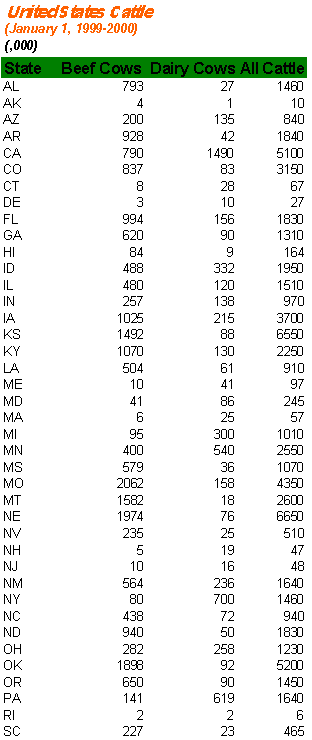

Contacts
Canadian Embassy - Washington
501 Pennsylvania Ave., N.W.
Washington, D.C. 20001, U.S.A
Contact: Cynthia Stevenson
Tel: (202) 682-7765
Fax: (202) 682-7619
Canadian Consulate General - Chicago
Two Prudential Plaza
180 N. Stetson Ave., Suite 2400
Chicago, Ill 60601, U.S.A.
Contact: Cathy Cameron
Tel: (312) 616-1873
Fax: (312) 616 1878
Canadian Consulate General - Atlanta
1175 Peachtree St. N. E
1700-100 Colony Square
Atlanta, Georgia 30361-6205, U.S.A
Contact: Carl Rockburne
Tel: (404) 532-2000
Fax: (404) 532-2050
Canadian Consulate General - Detroit
600 Renaissance Centre, Suite 1100
Detroit, Michigan 48243-1798, USA
Contact: Keith Jozwik
Tel: (313) 567-2208
Fax: (313) 567-2164
Canadian Consulate General - Boston
Three Copley Place, Suite 400
Boston, Mass. 02116, USA
Contact: Colette Lekborg
Tel: (617) 262-3760
Fax: (617) 262-3415
Canadian Consulate General - Minn
701 Fourth Ave. South, Suite 900
Minneapolis, MN 55415-1899, USA
Contact: Kent Jensen
Tel: (612) 332-7486
Fax: (612) 332-4061
Canadian Consulate General - Buffalo
One Marine Midland Centre, Suite 3000
Buffalo, NY 14203-2884, USA
Contact: Marcia Grove
Tel: (716) 858-9555
Fax: (716) 852-4340
Canadian Consulate General - NY
1251 Avenue of the Americas
New York City, NY 10020-1175, USA
Contact: Lisa Rambert
Tel: (212) 596-1656
Fax: (212) 596-1793
Canadian Consulate General - Seattle
412 Plaza 600, Sixth and Stewart Streets
Seattle, Washington 98101-1286, USA
Contact: Doug McCracken
Tel: (206) 443-0336
Fax: (206) 443-9662
U.S. Government Contacts
U.S. Department of Agriculture (USDA)
14th Street and Independence Avenue, SW
Washington, D.C. 20250, USA
Tel: (202) 720-2791
Internet: http://www.usda.gov
U.S. Department of Agriculture
Economic Research Service
1800 M Street, N.W.
Tel: (202) 694-5050
Fax: (202) 694-5757
Note: All USDA offices are accessible from the main telephone number.
U.S. Department of Agriculture (USDA)
Food Safety and Inspection Service (FSIS)
14th Street and Independence Avenue, SW
Washington, DC 20250, USA
Tel: (202) 720-7025
Fax: (202) 205-0158
Internet: http://www.fsis.usda.gov
U.S. Department of Agriculture
Foreign Agricultural Service (FAS)
American Embassy, Ottawa
490 Sussex Drive
Ottawa, Canada K1N 1G8
Tel: (613) 688-5267
Fax: (613) 688-3124
Internet Email: usagr@istar.ca
U.S. Department of the Treasury
U.S. Customs Service (USCS)
1300 Pennsylvania Avenue N.W.
Washington, DC 20229, USA
Tel: (202) 927-6724
Fax: (202) 927-1393
APHIS Branches (Animal and Plant Health Inspection Service)
Blaine, WA 98231
Animal Health (Port Veterinarian)
Plant Quarantine Division
(360) 332-8853
(360) 332-8891
Sweetgrass, MT 59484
(406) 335-2142
Pembina, ND 58271
(701) 825-6262
| Date Modified: 2001 01 01 | Important Notices |